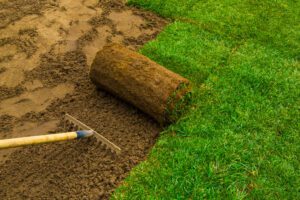Turf can be laid any time of year except on to frozen ground, however ideal times to lay turf are in early-mid autumn and early spring, when the ground is relatively warm – which will promote new root growth – and increased rainfall may reduce the need for manual watering.
Laying turf at these times of year also mean that the grass growth-rate will be slightly slower than in the warmer months of late spring and summer, therefore reducing the need for mowing within the first couple of weeks after laying and limiting the need to walk on the turf as it establishes.

That said, as long as the turf you are purchasing is healthy it’s possible to lay turf any time of year, except on to frozen ground, if the correct ground preparation and after-care are adopted. For example, if laying in the summer months care should be taken during extended periods of hot and dry weather. In these circumstances, particular attention would be required to ensure the new lawn is laid immediately upon delivery and receives sufficient water to thrive.
When arranging your delivery date, it’s important to consider that turf must be rolled out immediately upon delivery in spring and summer and within 24 hours in autumn and winter. The reason for this is that turf is a living, breathing roll of grass plants, microbes and tiny insects. When turf is rolled up it acts like a blanket, trapping warm air in the roll. As the micro-organisms use up the oxygen, other organisms within the turf that don’t require as much oxygen become more active, their growth then generates even more heat which can damage the grass; this is known as sod-heating.
Laying turf in winter
Most turf companies can deliver your order within three working days, so check the weather forecast and the prepared ground ahead of placing your order to ensure the soil isn’t frozen, or a hard frost predicted. As already mentioned, you should always roll out the turf within 24 hours of delivery, even when laying in colder months.
Due to less daylight hours in winter, if you are laying a particularly large area it would be prudent to begin laying immediately on the day of delivery and if necessary, complete the project the following day. This reduces the risk of your turf being rolled up longer than necessary. You may also wish to choose a morning delivery slot, if given the option.
Laying turf in autumn or spring
As we mentioned earlier, early to mid autumn is an ideal time of year to lay turf, however spring can also be a suitable time for laying turf, due to cooler temperatures and typically more rainfall than summertime, which should reduce watering requirements.
Frosts can still occur during spring and autumn, so it’s important to pay attention to the weather to make sure there isn’t a hard frost forecast on your delivery date.
In recent years, weather has been changeable and often extreme. Checking the weather will help you ascertain if there are going to be unseasonably warmer temperatures that you may need to consider, or rainfall forecast that will mean the turf will require watering less frequently while it is establishing.
Laying turf in summer
Due to the increased risk of sod-heating in the summer, laying straight away on the day of delivery is essential. If the turf doesn’t arrive until late afternoon or you don’t have time to lay it all in one day, then unroll the remaining, unused turf in a shaded area and water it; you can then finish laying the turf the following day.
Key things to remember in the summer are:
- Water your prepared soil prior to laying the turf.
- Begin laying turf immediately upon delivery.
- Keep turf rolls in the shade where possible.
- Never leave turf covered.
- Never water turf when it is still rolled up.
- Always unroll turf which is at risk of sitting unused for a number of hours or overnight; if not rolled out, it is likely that heat damage will occur.
- Water turf immediately after laying.
- If turfing a large area, or it is a warm day, lay and water the turf in sections to prevent the new lawn drying out.
If you are laying a particularly large area or turfing an area without assistance, you may wish to choose a morning delivery slot to allow yourself as much time as possible to lay your new lawn on the delivery day.
We hope you have found this article interesting. If so, please feel free to share on Facebook, Twitter and Pinterest. If you would like to stay up-to date with our news, advice and special offers, why not sign up to our newsletter.